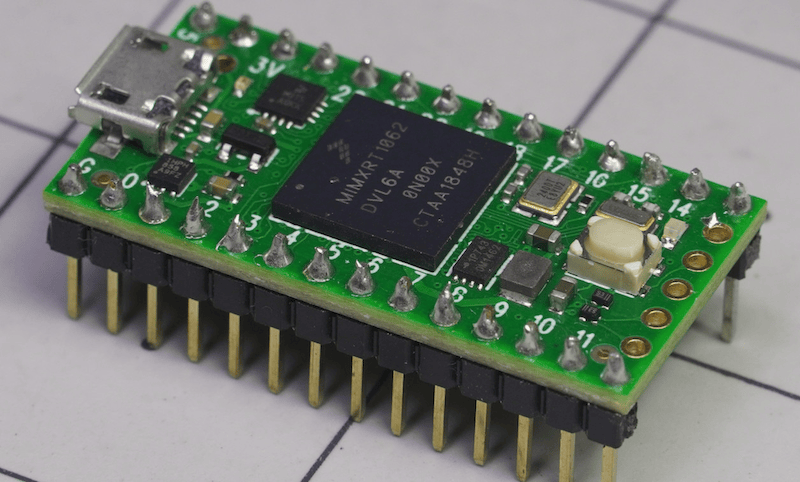Recent Posts
The Teensy Series of Processor Modules: A Versatile Platform for Embedded Systems
Posted by on
 The Teensy series of processor modules is a family of compact, high-performance microcontroller boards developed by PJRC. These boards are widely recognized for their small form factor, powerful processing capabilities, and extensive I/O support, making them an ideal choice for a variety of embedded systems applications, including robotics, audio processing, and IoT (Internet of Things) projects.
The Teensy series of processor modules is a family of compact, high-performance microcontroller boards developed by PJRC. These boards are widely recognized for their small form factor, powerful processing capabilities, and extensive I/O support, making them an ideal choice for a variety of embedded systems applications, including robotics, audio processing, and IoT (Internet of Things) projects.
History and Development
The Teensy series was introduced in 2008 by Paul Stoffregen, the founder of PJRC. The goal was to provide a small yet powerful microcontroller board that could offer more capabilities than the traditional Arduino boards. Over the years, Teensy has evolved through multiple versions, incorporating more powerful microcontrollers and expanding its feature set to cater to advanced applications.
Hardware Specifications and Variants
The Teensy family consists of multiple versions, each designed with different levels of processing power and memory to meet various application needs. Some of the most popular models include:
-
Teensy 2.0 – Based on the ATmega32U4 microcontroller, this board operates at 16 MHz and features 32 KB of flash memory. It was one of the early iterations offering built-in USB capabilities.
-
Teensy 3.2 – This version introduced a significant leap in performance, featuring the ARM Cortex-M4 processor running at 72 MHz, 64 KB RAM, and 256 KB flash memory.
-
Teensy 3.6 – Equipped with a Cortex-M4F processor running at 180 MHz, this board includes more RAM (256 KB) and flash memory (1 MB), as well as built-in support for microSD cards.
-
Teensy 4.0 – The fastest and most powerful Teensy board, featuring an ARM Cortex-M7 processor that can run at speeds up to 600 MHz. It provides 1 MB RAM and 2 MB flash memory, making it suitable for high-performance applications.
-
Teensy 4.1 – An enhanced version of the Teensy 4.0, with additional memory and expandability options, including Ethernet support and larger flash storage capabilities.
Key Features and Advantages
1. High Processing Power
One of the defining characteristics of the Teensy series is its high-speed processors, particularly in the newer models such as the Teensy 4.0 and 4.1. The ARM Cortex-M7 processor provides exceptional computational performance, allowing for advanced signal processing and machine learning applications.
2. USB and HID Support
Teensy boards natively support USB communication, allowing them to function as USB keyboards, mice, MIDI controllers, and serial devices. This feature is particularly useful for creating custom input devices, musical instruments, and gaming peripherals.
3. Compatibility with Arduino IDE
Despite its superior hardware, Teensy remains compatible with the Arduino IDE through the Teensyduino add-on. This makes it accessible to developers familiar with Arduino programming while providing more advanced capabilities.
4. Extensive I/O and Connectivity Options
Teensy boards feature a wide range of I/O options, including:
-
Multiple PWM (Pulse Width Modulation) channels
-
Analog and digital inputs
-
SPI, I2C, UART communication protocols
-
Built-in SD card support (on select models)
-
Ethernet expansion (on Teensy 4.1)
5. Real-Time Capabilities
With its high-speed processing and dedicated real-time processing features, the Teensy series is well-suited for applications requiring precise timing and responsiveness, such as motor control, audio synthesis, and real-time data acquisition.
Applications of the Teensy Series
Due to its versatile nature, the Teensy series finds applications in various fields:
-
Audio Processing: The Teensy Audio Library provides tools for high-quality audio synthesis, making the board popular among electronic musicians and sound engineers.
-
Robotics: Teensy's fast processing power and extensive I/O support make it ideal for controlling robots, drones, and automated systems.
-
IoT and Networking: With its USB, serial, and Ethernet capabilities, Teensy is a great platform for developing IoT devices and networked applications.
-
Embedded Systems Research: Many researchers use Teensy for rapid prototyping and development of embedded systems due to its flexibility and performance.
Conclusion
The Teensy series of processor modules has carved a niche in the embedded systems community by offering an impressive balance of power, compact size, and ease of use. Whether for hobbyists, engineers, or researchers, Teensy boards provide a robust platform for a wide range of applications. With continued advancements in microcontroller technology, Teensy is likely to remain at the forefront of high-performance embedded computing for years to come.
 Teensy 4.1 Triple CAN Bus Board with 240x240 LCD and Ethernet
Teensy 4.1 Triple CAN Bus Board with 240x240 LCD and Ethernet
This is a Teensy 4.1 board featuring triple CAN connections—two CAN 2.0B and one CAN FD—along with an Ethernet MagJack for network connectivity. It supports external +12V DC power input with built-in reverse voltage protection. Also included is a 240x240 wide-angle IPS TFT LCD display for crisp, vibrant visuals.
Powered by an Arm Cortex-M7 microcontroller running at 600 MHz, the Teensy 4.1 is fully Arduino-compatible and works seamlessly with the Arduino IDE and libraries. In most cases, code written for other Arduino boards requires minimal modifications to run on the Teensy. More Information...
 Loading... Please wait...
Loading... Please wait...
